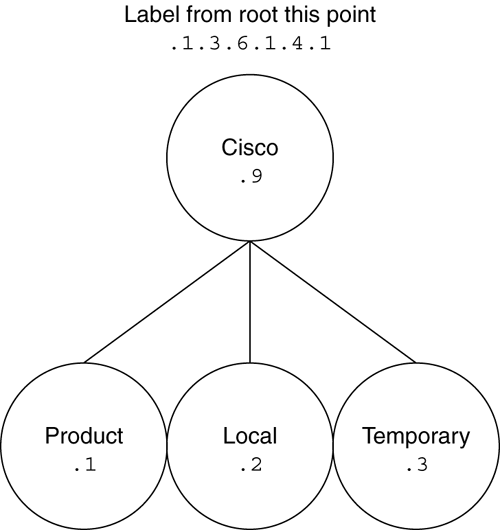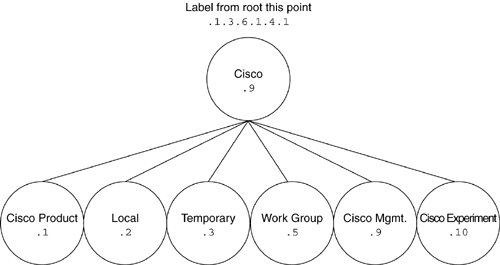| Previous to IOS 10.2 the base structure of the Cisco MIB branch is shown in Figure A-1. Figure A-1. Cisco MIB Branch, Pre-IOS 10.2
The following list describes the various component branches of the Cisco MIB branch: Product branch The product branch holds the sysObjectIDs for most Cisco products. This object identifies the type of productsuch as a 4700 or a 7507 router. Most NMS applications use the sysObjectID to identify the network devices in their database and on the topology map. Local branch The local branch originally was the branch where most management objects were located. However, much of the local branch is defined in the OLD-CISCO-* MIB files on CCO. These objects are now deprecated and will be rendered obsolete in some future version of IOS. Much of the same data is available from newer, more powerful objects in the new CiscoMgmt branch. NOTE The term deprecated has a specific meaning when referring to MIB objects. It was first introduced in RFC 1158 (the first definition of MIB II). A deprecated object must still be supported but it may be replaced in some future MIB document by a new object of similar or superior functionality. It is important to note which objects are deprecated because you may want to limit their use or at least be prepared to migrate if they become obsolete.
With the move away from a monolithic MIB file to component MIB files, new branches were defined, as shown in Figure A-2. Only the branches commonly used are shown in this figure. Figure A-2. Cisco MIB Branch, Post-IOS 10.2
The new MIB structure still has the CiscoProducts branch where the sysObjectID of most Cisco devices are stored. The local and temporary branches are still there. Most local objects are still supported, even though they have been deprecated. The transition to the new MIB structure marks the support of SNMPv2 SMI (Structure of Management Information). Virtually, all MIB objects for the local branch are SNMPv1 SMI. The branches currently used are as follows: Cisco management branch The new structure adds the CiscoMgmt branch, under which most new Cisco MIB objects are defined. Most of the older branches from the local branch also have equivalent branches here. For example, the lflash branch under the local branch has been replaced by the CiscoFlashMIB under the CiscoMgmt branch. Workgroup branch The workgroup branch contains objects supported on the workgroup Catalyst switches, such as the Catalyst 4000, 5000, and 6000 families. The commonly used CiscoStackMIB branch is located here. The sysObjectID objects for the Catalyst 4000,5000, and 6000 families of devices are also defined here rather than the CiscoProduct branch. Experimental branch The CiscoExperiment branch is now where all new MIB work is based. These may be either IETF or Cisco work-in-progress MIBs. For example, objects defined by IETF-draft MIBs may be implemented first under this branch. However, support for such objects under the CiscoExperiment branch will be deleted when a permanent place is assigned. There are other branches defined, but the preceding branches are the ones currently used. |

